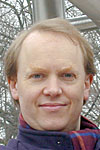
Otto-Lilienthal-Gedenkstätte
Berlin-Steglitz (Lichterfelde), Schütte-Lanz-Straße, Germany
June 21, 2005 -- approx. 20:00 MESZ (18:00 UTC)
© 2005 Martin Frech, All Rights Reserved.
Nevertheless, Lilienthal's contributions to the development of heavier-than-air flight remain significant. Often working in conjunction with his brother, Gustav, he made over 2000 flights in gliders of his design between 1891 and his death five years later. Lilienthal did basic research in precisely describing birds flight, especially of storks and used polar-diagrams for describing the aerodynamics of their wings. Lilienthal helped to prove that heavier-than-air flight was practical without flapping wings, laying the groundwork for the Wright brothers a few years later to build the first successful powered airplane.
Lilienthal suffered a number of crashes in his experiments, but his aircraft could only reach low speeds and altitudes. On 9 August 1896, a gust of wind fractured his wing and he fell from a height of 17 m, breaking his spine. He died the next day, saying, "Opfer müssen gebracht werden!" ("Sacrifices must be made!")
(The above text is licensed under the GNU Free Documentation License. It uses material from the Wikipedia article "Otto Lilienthal".)
Otto Lilienthal had the "Fliegeberg" built in 1893 in order to be able to carry out his flying experiments regardless of the wind direction. This first "artificial airport" of the world was redesigned by Fritz Freymüller in 1932 to become the Lilienthal Memorial, as shown in my panorama.
A good starting point for further informations is the Otto-Lilienthal-Museum-Website.
And what has this got to do with our subject? I, too, asked myself why an artificial pond was created in memory of a man who was obsessed with flying.
Once again, as in almost all my Wrinkle-/WWP-contributions, I have chosen a motif which relates to the area where I live and work.
(Translation: Vera Olbricht)


 Tap or click the zoom icon in the bottom right corner of the picture to switch between in-page and fullscreen view
Tap or click the zoom icon in the bottom right corner of the picture to switch between in-page and fullscreen view